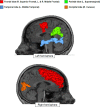Regional Brain Glucose Hypometabolism in Young Women with Polycystic Ovary Syndrome: Possible Link to Mild Insulin Resistance
- PMID: 26650926
- PMCID: PMC4674147
- DOI: 10.1371/journal.pone.0144116
Regional Brain Glucose Hypometabolism in Young Women with Polycystic Ovary Syndrome: Possible Link to Mild Insulin Resistance
Abstract
Objective: To investigate whether cerebral metabolic rate of glucose (CMRglu) is altered in normal weight young women with polycystic ovary syndrome (PCOS) who exhibit mild insulin resistance.
Materials and methods: Seven women with PCOS were compared to eleven healthy female controls of similar age, education and body mass index. Regional brain glucose uptake was quantified using FDG with dynamic positron emission tomography and magnetic resonance imaging, and its potential relationship with insulin resistance assessed using the updated homeostasis model assessment (HOMA2-IR). A battery of cognitive tests was administered to evaluate working memory, attention and executive function.
Results: The PCOS group had 10% higher fasting glucose and 40% higher HOMA2-IR (p ≤ 0.035) compared to the Controls. The PCOS group had 9-14% lower CMRglu in specific regions of the frontal, parietal and temporal cortices (p ≤ 0.018). A significant negative relation was found between the CMRglu and HOMA2-IR mainly in the frontal, parietal and temporal cortices as well as in the hippocampus and the amygdala (p ≤ 0.05). Globally, cognitive performance was normal in both groups but scores on the PASAT test of working memory tended to be low in the PCOS group.
Conclusions: The PCOS group exhibited a pattern of low regional CMRglu that correlated inversely with HOMA2-IR in several brain regions and which resembled the pattern seen in aging and early Alzheimer's disease. These results suggest that a direct association between mild insulin resistance and brain glucose hypometabolism independent of overweight or obesity can exist in young adults in their 20s. Further investigation of the influence of insulin resistance on brain glucose metabolism and cognition in younger and middle-aged adults is warranted.
Conflict of interest statement
Figures


References
-
- Bingham EM, Hopkins D, Smith D, Pernet A, Hallett W, Reed L, et al. (2002) The role of insulin in human brain glucose metabolism: An 18fluoro-deoxyglucose positron emission tomography study. Diabetes 51: 3384–3390. - PubMed
Publication types
MeSH terms
Substances
LinkOut - more resources
Full Text Sources
Other Literature Sources
Medical

